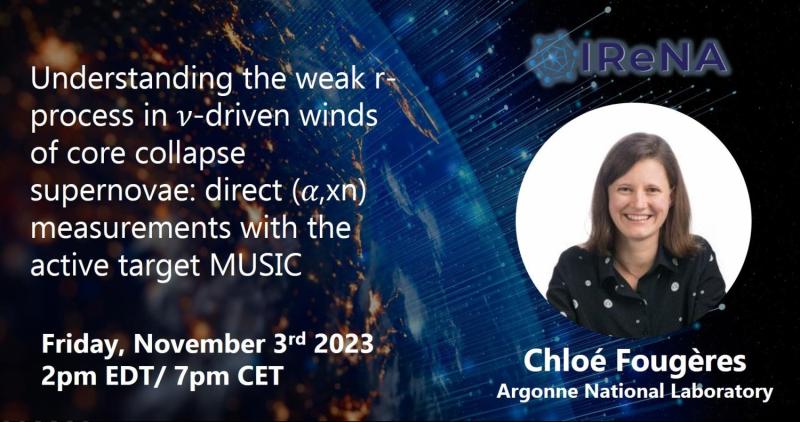Data
You will be redirected to cenamweb.org in 15 second(s). The JINA-CEE website is not updated anymore. The archived website can still be reached through the CeNAM website.
Understanding the weak r-process in 𝜈-driven winds of core collapse supernovae: direct (𝛼,xn) measurements with the active target MUSIC featuring Chloe Fougeres (Argonne National Laboratory)

Hosted by: Jennifer Sanchez Rojo (TRIUMF)
Half of the elements heavier than iron are expected to be produced by the r-process consisting of rapid neutron-capture reactions on stable and unstable neutron-rich nuclei. The other half mostly originates from the slow neutron-capture process (s-process). Although recently proven to occur during neutron-star mergers, other sites of the r-process and other mechanisms are still under consideration to explain the abundance patterns above Fe. For instance, a subset of old (low metallicity) stars presents elemental abundances at the first peak possibly explained by the weak r-process. The latter is thought to be active in neutron-star mergers and/or 𝜈-driven winds after core-collapse supernovae (CCSNe). In the second environment, the synthesis of elements around Z~40 is mainly driven by (𝛼,n) and (n,𝛾) reactions at temperatures within [2, 5] GK. However, 𝛼-induced reactions have been poorly measured to date. Therefore, rates are presently calculated with the statistical Hauser-Feshbach modes where nuclear physics inputs like the choice of an 𝛼-Optical-Model Potential (𝛼-OMP) lead to uncertainties of several orders of magnitude. These nuclear uncertainties are too important to gain insights on the CCSNe 𝜈-driven wind conditions while comparing models to observed elemental abundances in metal-poor stars. Hence the need for experimental work on (𝛼,n) reactions affecting the weak r-process in CCSNe 𝜈-winds as well as nuclear reaction theory.
Two experiments were performed at the Argonne Tandem Linac Accelerator System facility to measure, for the first time, the cross sections of 88Sr(𝛼,n)91Zr and 87Rb(𝛼,xn)Y at astrophysics energies (Ecm ~ 8-13 MeV). Such experiments relied on the active gaseous target technique, in inverse kinematics, with the MUlti Sampling Ionization Chamber (MUSIC). They made use of the detector efficiency of 100 % and its electrically-segmented anode to measure the excitation function at different energies while the incident beam slows down in the gas. Digital data acquisition electronics, employed for the first time, allowed higher rates (x8). Results on these two weak r-process (𝛼,xn) reactions will be given. Measured cross sections have been compared to statistical Hauser-Feshbach calculations, bringing so constrains on the 𝛼-OMP. The thermonuclear reaction rates have been evaluated with strongly reduced uncertainties. Future experimental efforts on the weak r-process in CCSNe 𝜈-winds will be finally discussed.
